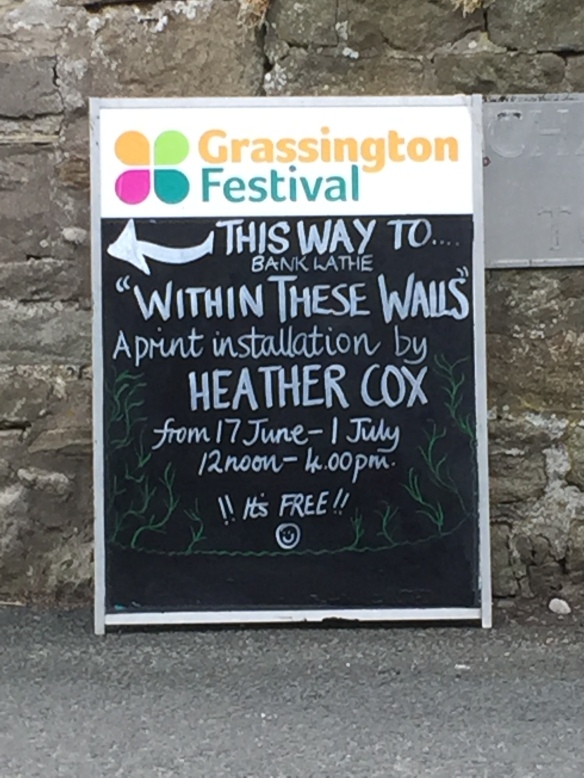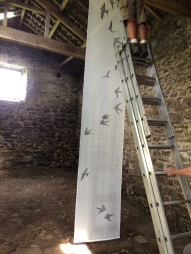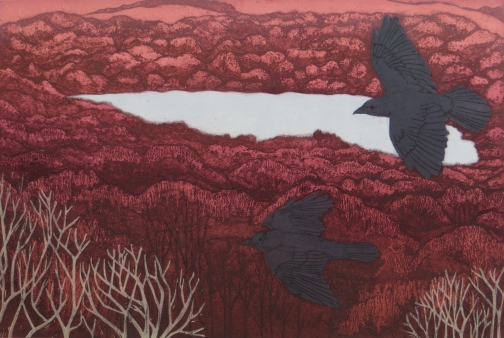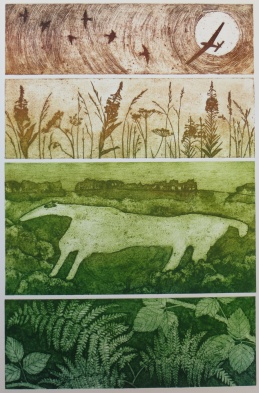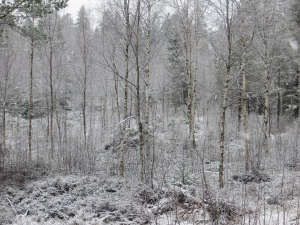It’s been a busy few weeks. Last week was an exciting mix of workshops and meetings and culminated in the Connections North Seminar at Harrogate Studio Theatre. This concentrated on the artists residency opportunities available to artists in North Yorkshire . Arts Connections had invited me to speak about my experience of doing my printmaking residency at Ålgården in Sweden. Others giving presentations were representatives from the Finnish, Scottish and Swedish centres as well as Sarah Smith, a fellow artist who did a stone carving residency in Sweden, and a representative from the Arts Council of England. It was an exciting and inspiring day and I was especially pleased to see Christina Lindberg and Anna Mattsson again.
This week I have been mainly outdoors!
A few months ago Paul Mosley, Hackfall Officer for the Woodland Trust, asked me if I would be interested in running an Inset day for teachers at Hackfall Woods with the emphasis on printmaking outdoors. Always up for a challenge and with Hackfall being a favourite place of mine, I agreed. 27th March seemed a long way away and I was sure that on the day I would be leading a group of teachers happily making prints in the sunshine as the birds sang. Suffice to say that, as the snow fell and then fell again, I have been worrying about the workshop for some weeks!
I’m a bit of a perfectionist and tend to be meticulous in my lesson planning so I knew that the only way to ensure success was to do a dry run of the workshop the day before it took place. That way I could ensure that everything would work in the current weather conditions. So I can actually say that I spent two days printmaking in the snow 🙂
Using ArtisOn as a base, Paul and I met our 12 teachers along with Hackfall volunteer Sue Cockcroft, who was invaluable as a printmaking assistant. We then set off to Hackfall in the minibus. Paul had explained the idea of story sticks and a couple of the teachers decided to have a go. Story sticks are a way to engage a child’s attention right from the start of the visit by getting them to look for found objects to attach to their stick using rubber bands throughout their walk. This provides a visual record of their journey through the woods. Apparently it stems from an aboriginal practise.

I then discussed the Geoartcache project that I was commissioned to do by Chrysalis Arts for North Yorkshire Open Studios last year. I’ve created a trail in the woods that combines printmaking, book art, wildlife and folklore. Further details are on the Geoartcache website. Originally the trail consisted of 10 caches and the book cache but it has been adapted to allow for the caches that have gone AWOL due to flooding, storms and skulduggery! There are now six stamp caches and the book cache so do go and have a look if you are in the area.

Slipping about a bit, we headed down the hill for a spot of bark rubbing and the chance to ‘meet a tree’ before heading to the ‘beach’ to do sun printing (ha!). I love sunprinting and it has so much scope as an educational tool. It is based on the principles of cyanotype which was discovered in the nineteenth century and became popular with engineers as a low cost way of reproducing their designs as ‘blue prints’. Anna Atkins used it to record her extensive plant and seaweed collection and these were collected together in what is generally considered to be the first book published with photographic illustrations. She is also considered by some to be the first female photographer although that is open to speculation with Constance Talbot (Henry Fox Talbot’s wife) often being cited as the first (amongst others). Anyway, the process is great for combining science and art and I soon had my teachers creating photograms by looking for interesting found objects such as leaves, twigs, feathers and sand to create images with. They then laid the objects on the light sensitive paper and placed a piece of perspex over the top to hold them in place whilst we waited for the weak sun to do its work.

Fortunately, you can sunprint even when its cloudy so within ten minutes the exposed parts of the blue paper had turned a very pale bluey white and the paper was ready to be developed in my little tub of river water,

The chemical in the parts of the paper that have not been exposed to UV light are water soluble and wash away leaving the paper white whereas the UV exposed parts turn a dark blue. The blue deepens as the paper dries to become a beautiful cyan blue (a clue is in the name).

I layered all the developed prints carefully in small sheets of blotting paper to dry and we headed along the muddiest path in Hackfall to check out one of my geoartcaches, ‘Waterdog’. I retold the story of St.Cuthbert and the otters and demonstrated the stamp and then we headed to my favourite folly, Fisher’s Hall, for a spot of monoprinting. I love this folly. Its a magical and meditative spot where you can sit and watch the river whilst listening to the birds. Here it is earlier in the year.
I had to use oil-based water soluble relief printing ink from Lawrence Art Supplies as my speedball inks didn’t perform very well the day before because of the cold.

Everyone managed to make some lovely monotypes despite cold fingers but we decided that plasticine printmaking at the pond might just tip some of the less hardier members of the group into hypothermia so, instead, we headed up to the banqueting house to admire the view across the valley and in the other direction, to Mowbray Castle.

Chris was waiting with his minibus at the car park to take us back to ArtisOn for lunch. Sue Palin spoilt us with three delicious soups and bread followed by scones and two kinds of cake 🙂 Full up and a bit rosy cheeked from the snow, I then set about showing the teachers how to make prints and stamps from funfoam, how to explore textures of found objects by printing from plasticine and the amazing things you can do with relief collagraph techniques. None of which need a press or any expensive materials. Here’s one of my collagraph sample boards:

The teachers getting stuck in to making stamps.

All in all it was an excellent day and proved that the weather should be no obstacle to having a good time! In fact I distinctly recall the first workshop that I ever did for the Woodland Trust which involved me leading a group of printmakers around Hackfall in the pouring rain to gather inspiration for two days of collagraph printmaking. The results were amazing and reflected the weather.

So, if anybody is now keen to come printmaking in the woods, Paul is running a Family Day at Hackfall on the 10th April, 11am – 4pm. There will be pond dipping and I will be based in the Rustic Temple doing printmaking. Adults and children are welcome to come and have a go. For more information visit the Hackfall website. Booking not required. Hope to see some of you there and perhaps we will have some sunshine! 🙂

